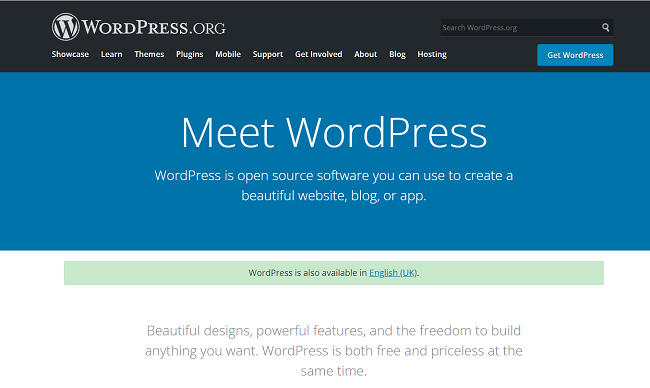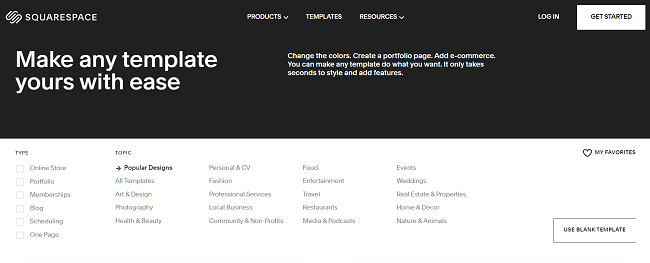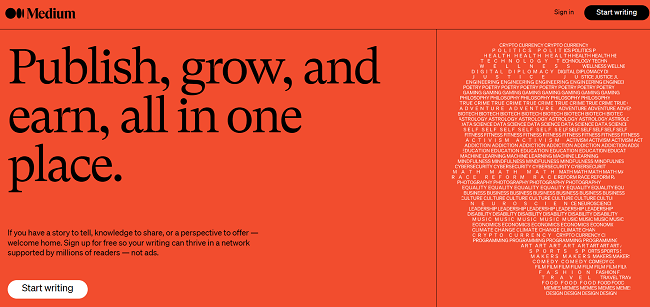9 Best Blogging Platforms For 2022: Free & Paid Options Compared
Planning to start a blog but not sure which blogging platform to use? We’ve got you covered.
If you’re a beginner, you’ll want to look for a platform that makes it easy to set up your website without any coding. It should be SEO-friendly, offer extensive customization options, and be flexible enough that it leaves room for growth.
In this post, I’m comparing. the best blogging platforms that fit the bill.
I’ll be reviewing and comparing each blogging platform in detail to help you find the best solution for your needs.
What is the best blogging platform? Our top 3 picks.
TL;DR
This post is going to go into plenty of detail to make sure you have all the information you need to make an informed decision on choosing the best blogging platform right for your needs.
But if you don’t have time to read it all, here’s the short version.
Our top three recommendations for the best blogging platforms are:
- WordPress.org with DreamHost – The overall best blogging platform for beginners and experienced bloggers alike, thanks to complete flexibility and ownership.
- Squarespace – The best blogging platform for simplicity and the easiest one to learn.
- BigCommerce Essentials – The best blogging platform for building an eCommerce store with built-in blogging features.
Of course, these aren’t the only options out there, and there’s a lot more to say about each of them. Read on and we’ll tell you everything you need to know.
#1 – WordPress.org with DreamHost
WordPress (hosted with DreamHost) is the best blogging platform for beginners and experienced bloggers. Close to 40% of the websites on the internet are powered by WordPress.org.

The reason WordPress is so popular is because of how flexible and scalable it is. It’s an open-source content management system (CMS) that gives you complete control over every single aspect of your blog.
Because it’s open-source, anyone can create their own WordPress themes or plugins and make them available for others to install on their site. As a result, there are nearly 60,000 free plugins in the WordPress plugin library and countless more paid ones.
You can use these plugins to customize your site and extend its functionality. For example, want to add a live chat box to your blog? There’s a plugin for that.
Or perhaps you’d like to create and add some lead collection forms to help grow your audience? There’s a plugin for that too.
And there are other reasons to choose WordPress aside from its flexibility. For example, it’s the best choice when it comes to search engine optimization (SEO) as it has plenty of SEO features baked in.
You can also take advantage of plugins like Yoast to help you optimize your site and written content. If you’re planning on driving visitors to your blog from organic search, this is super important.
Blogging on WordPress is fairly straightforward. The Gutenberg editor allows you to layout your blog content in neat ‘blocks’. You can embed images, videos, graphs, charts, or pretty much anything else without having to mess around with code.
The downside of WordPress is that it does have a bit of a learning curve. You’ll need to spend a lot more time managing the back-end to make the most out of it.
Hosting your WordPress blog
Unlike most of the other blogging platforms on this list, WordPress.org isn’t a complete blogging platform solution – it’s a self-hosted solution that only provides the software you need to actually build your blog. You need to sign up for a web hosting service separately.
We recommend DreamHost for beginners to WordPress. It’s affordable, includes solid support, offers excellent speed/performance, and makes for a great blogging platform to build upon for the future. It also comes with WordPress pre-installed so it’s super easy to get started with once you sign up.
Plus, due to the flexibility of WordPress.org, you can always upgrade to another host at any point in the future if you so choose.
Pros and cons of WordPress.org with DreamHost
| Pros | Cons |
| Endlessly extensible with plugins | Higher learning curve |
| SEO features baked in | The front-end website builder isn’t as easy to use as other platforms |
| Scalable | |
| Affordable (WordPress is free and WordPress hosting is cheap) | |
| Gives you full control |
Pricing
DreamHost’s shared WordPress hosting packages (which come with WordPress pre-installed and a free domain name) currently start from just $2.59 per month. Note that this may be an introductory offer and regular prices may vary.
DreamHost offers a 97-day money-back guarantee if you’re not happy.
#2 – Squarespace
Squarespace is a popular all-in-one website building platform that makes it easy to create beautiful websites from scratch using an intuitive drag-and-drop editor.

It’s ideal for beginner bloggers and small business owners who want to start growing their online presence as it’s super simple and easy to learn – their setup wizard walks you through every step.
You don’t need any design or coding skills to get started. Simply choose a professionally designed website template from Squarespace’s extensive library, add your blog page, customize the design and layout to make it match your branding and storytelling style, and start creating your content.
All templates can be extensively customized. You can choose between a ton of different designs, color palettes, fonts, and flexible layout options. For example, you might choose to display your blog posts side-by-side, in a basic grid layout, or in a single column.
Squarespace also gives you access to free images on Unsplash and allows you to tweak them by using the built-in photo editing features.
Once you’ve started creating content, you can promote your blog posts using Squarespace’s integrated suite of powerful marketing tools and track your blog traffic through robust in-built analytics.
Unlike WordPress.org, Squarespace takes care of the hosting side of things for you. You also get a free custom domain name, SSL Security, and access to 24/7 support when you sign up for a paid plan.
Pros and cons of Squarespace
| Pros | Cons |
| Very easy to use (ideal for beginners) | Very limited integration options |
| Gives you access to stunning, professionally designed templates | Not as scalable or flexible as WordPress |
| Includes powerful marketing and analytics features | |
| Highly customizable |
Pricing:
Squarespace plans start from $12 per month if you sign up for an annual subscription. You can also try it out for free before you buy.
#3 – BigCommerce Essentials
BigCommerce is a well-known eCommerce platform with built-in blogging capabilities. It makes it easy for users to create an online store, drive traffic to it, and start selling.

If you’re hoping to monetize your blog by selling physical or digital products, BigCommerce Essentials might be the solution you’re looking for.
First, design and customize your own beautiful storefront using the no-code Page Builder tool. Then, set up a streamlined one-page checkout experience and easily integrate it with your favorite POS provider so you’re ready to start selling.
You can also take advantage of integrated shopping cart recovery to optimize your store for maximum conversions and use the in-built inventory management and shipping tools to take care of all the day-to-day tasks involved in running an eCommerce store.
A basic blog is included in the BigCommerce platform, but the look and feel of it will depend on which theme you choose. You can publish blog content to help boost your site’s visibility in the search engines.
You can also make sure your products are listed everywhere your customers shop as BigCommerce integrates with Amazon, eBay, Google Shopping, and Facebook.
Pros and cons of BigCommerce Essentials
| Pros | Cons |
| Ideal for eCommerce businesses | Not ideal for bloggers who don’t want to sell products |
| Integration with leading marketplaces and POS providers | Less affordable than other blogging platforms |
| Built-in inventory management and shipping tools | |
| Easy to use page builder | |
| Built-in SEO |
Pricing:
The standard BigCommerce Essentials plan starts from $29.95 per month. You can also take advantage of a 15-day free trial.
#4 – Medium
Medium is somewhere between a blogging platform and a social media site. It provides an easy way for bloggers and journalists to publish their writing to a platform with a large audience, without having to set up their own website.

Medium isn’t like the other blogging platforms on this list – and it certainly isn’t for everyone. It’s a place where anyone can create their own page on the Medium domain (https://medium.com/@yourname) and start writing and publishing content.
Because you’ll be writing for an existing site, you don’t need to build your own from scratch, which makes it an easy option. Medium also has a huge existing community of readers, which makes your posts more visible right from the get-go.
The tradeoff, of course, is that you won’t have complete ownership, or be able to monetize your traffic in the same way as you would if you published to your own site.
That isn’t to say you can’t make any money. The Medium Partner Program allows writers to get paid for their articles based on how much engagement it generates. If you can craft a post with lots of viral potential, there’s no reason you can’t make a good income from it.
Pros and cons of Medium
| Pros | Cons |
| Easy to get started with (no need to build a website) | No ownership |
| Anyone can sign up for free | No control over the layout/design |
| Built-in community of readers | Less easy to monetize your blog posts |
| Writers can get paid through the Partner Program |
Pricing:
It’s free for creators to sign up to Medium and join the Partner Program.
#5 – WordPress.com
WordPress.com (not to be confused with WordPress.org; our number one spot) is a WordPress blog hosting service powered by Automattic. It’s a popular choice for hobby bloggers who want to get started quickly.

Remember how we mentioned that WordPress.org is the open-source software you use to build your blog, but that it doesn’t provide web hosting?
Well, WordPress.com does. It’s a freemium hosting platform built with the same WordPress CORE software. It was created by the founder of WordPress.org as a way to make it easy for users to set up a live WordPress blog.
Read more: WordPress.com vs WordPress.org
The great thing about WordPress.com is that it’s free, as long as you’re happy with a WordPress branded subdomain (e.g. https://yourwebsite.wordpress.com), ads, and very limited customization options. This makes it a good choice for hobbyists that aren’t too concerned about branding, traffic, or monetization.
If you want your own domain or to unlock additional customization options, storage, and other features, you’ll need to upgrade to a paid plan.
Pros and cons of WordPress.com
| Pros | Cons |
| Great for hobbyists | Free version limited to a WordPress subdomain |
| Free option available | No ownership |
| Easy to use | Very limited flexibility and customization options |
| Little to no setup is required |
Pricing:
You can get started with WordPress.com for free on a subdomain, but you’ll have WordPress.com ads and branding on your site.
Paid plans start at $4 per month. Upgrading to a paid plan will remove the WordPress ads from your site and allow you to use your own custom domain.
#6 – Ghost
Ghost is a relatively new blogging platform that was founded in 2013 following a successful Kickstarter campaign. It takes a minimalist approach to content management and is designed specifically to meet the needs of bloggers and journalists.

You can think of Ghost as a younger, more exciting version of WordPress. The founders were aiming to revolutionize professional publishing and wanted to build a fantastic open-source platform around that specific use case.
The difference between WordPress and Ghost is that WordPress tries to be flexible enough for everything, whereas Ghost focuses specifically on offering the best possible publishing experience.
As part of that goal, Ghost has implemented a rich editor with flexible post formatting for the best possible writing experience.
The blogging platform also has a built-in suite of tools designed to help writers develop audience relationships. This includes registration forms, membership management tools, subscription support, native SEO features, and more.
And unlike WordPress, all these features are included right out of the box – you don’t need to install any extra plugins.
Ghost also claims to be up to 1,900% faster than WordPress thanks to the modern technology stack it’s built on. Over 2.5 million bloggers and journalists have installed Ghost to date.
Pros and cons of Ghost
| Pros | Cons |
| Built specifically for blogging and writing | Less flexible than WordPress |
| Clean and simple interface | Not as easily extensible |
| Super fast infrastructure | A limited number of themes to choose from |
| Little to no setup is required | |
| Tons of useful tools included out of the box |
Pricing:
Like WordPress, the core Ghost application is available for free under an open-source license. The company also offers a premium platform for people who want a managed hosting service and the best possible experience.
Paid plans start from $9/month. You can also take advantage of a 14-day free trial.
#7 – Tumblr
Tumblr is a popular microblogging platform with built-in social networking features. It’s completely free and perfect for hobbyists.

Tumblr is another solution that’s somewhere between a blogging platform and a social network.
In its heyday, Tumblr was one of the most successful social media platforms around. It was the place to go to share your thoughts and connect with others and has powered over 533.9 million blogs to date.
It might not be as popular as it once was, but it still has a thriving community with over 450 million users. Anyone can sign up to the publishing platform for free and publish engaging multimedia blog content to tap into this huge audience of potential readers.
Aside from publishing content, you can also take advantage of the platform’s social networking features like social sharing and reblogging tools to connect with your audience and grow your readership.
Related: How to get more followers on Tumblr
Pros and cons of Tumblr
| Pros | Cons |
| Great for hobbyists | Not as suitable for businesses |
| Fun and easy to use | Difficult to move to other blogging platforms as you grow |
| Integrated social media tools and features | Limited features and little flexibility |
| Great for publishing multimedia content (add videos, GIFs, images, and audio to your posts) | No ownership |
| Completely free |
Pricing:
Tumblr is completely free to use with a Tumblr subdomain.
If you want to connect a custom domain name to your account, you’ll have to purchase one separately from a registrar like GoDaddy or Bluehost.
Premium Tumblr themes are also available; costs range from $9 to $49.
Read more: WordPress vs Tumblr
#8 – Weebly
Weebly is a powerful, free website builder and eCommerce blogging platform that’s owned by Square’s payment solution.

It was founded in 2007 and powers over 50 million websites. Weebly’s front-end website builder is easy to use, and it offers one of the best catalogs of fully customizable, professionally-designed themes around.
Even if you’re a total beginner, you’ll find it easy to create a website to host your blog with Weebly. You can implement stunning effects like Parallax scrolling in just a few clicks, and with no coding required.
You can use the blog feature to write and publish posts, and utilize their collection of free blog templates to help with the design element.
The blogging platform also comes with tools to help you with your marketing efforts. You can use them to build your newsletter, promote your posts on social media, optimize your site for SEO, and more.
Pros and cons of Weebly
| Pros | Cons |
| Fully-hosted, all-in-one platform | Not as flexible as WordPress |
| Integrates well with the Square payment platform | Limited bandwidth and Weebly branded subdomain on the free plan |
| Beginner-friendly website builder | |
| Little setup required to get started |
Pricing:
Weebly is free for basic use, but you’ll be limited to a Weebly branded subdomain.
Paid plans that allow you to connect a custom domain start at $6/month.
#9 – Blogger
Last but not least, let’s talk about Blogger – a free blogging service by Google that offers a quick, hassle-free way to start your own blog.

Blogger has been around for a long-time. It was launched all the way back in 1999, which makes it one of the early pioneers of internet blogging.
While not as popular as it once was, Blogger is still a popular blogging platform, especially amongst hobbyists. It’s completely free to use, and you can get started in minutes. All you have to do is sign up, choose a template, and start writing.
Of course, like other free blogging platforms, you’re limited to a branded subdomain (https://yoursite.blogspot.com/), so it’s not as suitable for businesses or serious bloggers that want to host their blog on a site under their own branding.
Read more: WordPress vs Blogger
Pros and cons of Blogger
| Pros | Cons |
| Completely free | Only includes very basic blogging tools |
| Very easy to use and beginner-friendly | Not very flexible |
| Secure and reliable | Limited design options |
| Owned by Google | No ownership |
Pricing:
Blogger is completely free to use. If you want to connect your own custom domain, you’ll need to purchase one separately.
Choosing the best blogging platform for your business
Choosing the best blogging platform is vital as it can literally make or break the success of your blog, so it’s important to make the right decision.
If you’re still not sure which option is right for you, here’s a reminder of our top three recommendations:
- Choose WordPress.org with DreamHost if you want the best all-around option and complete control.
- If simplicity is important to you, go for Squarespace. It’s super easy to use and includes everything you need.
- Sign up for BigCommerce Essentials if you plan on using your blog to drive traffic to your eCommerce store.
If you’re looking for the best free blogging platforms consider trying Medium, Tumblr or Blogger. There are limitations, however, it’ll get your content out there.
We hope you found this helpful. Good luck!

Comments
Post a Comment